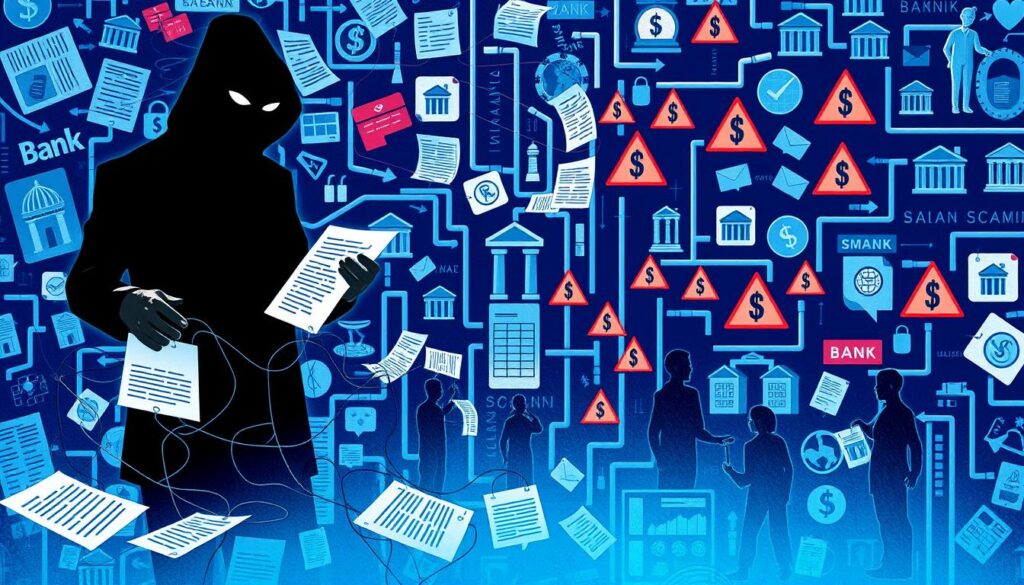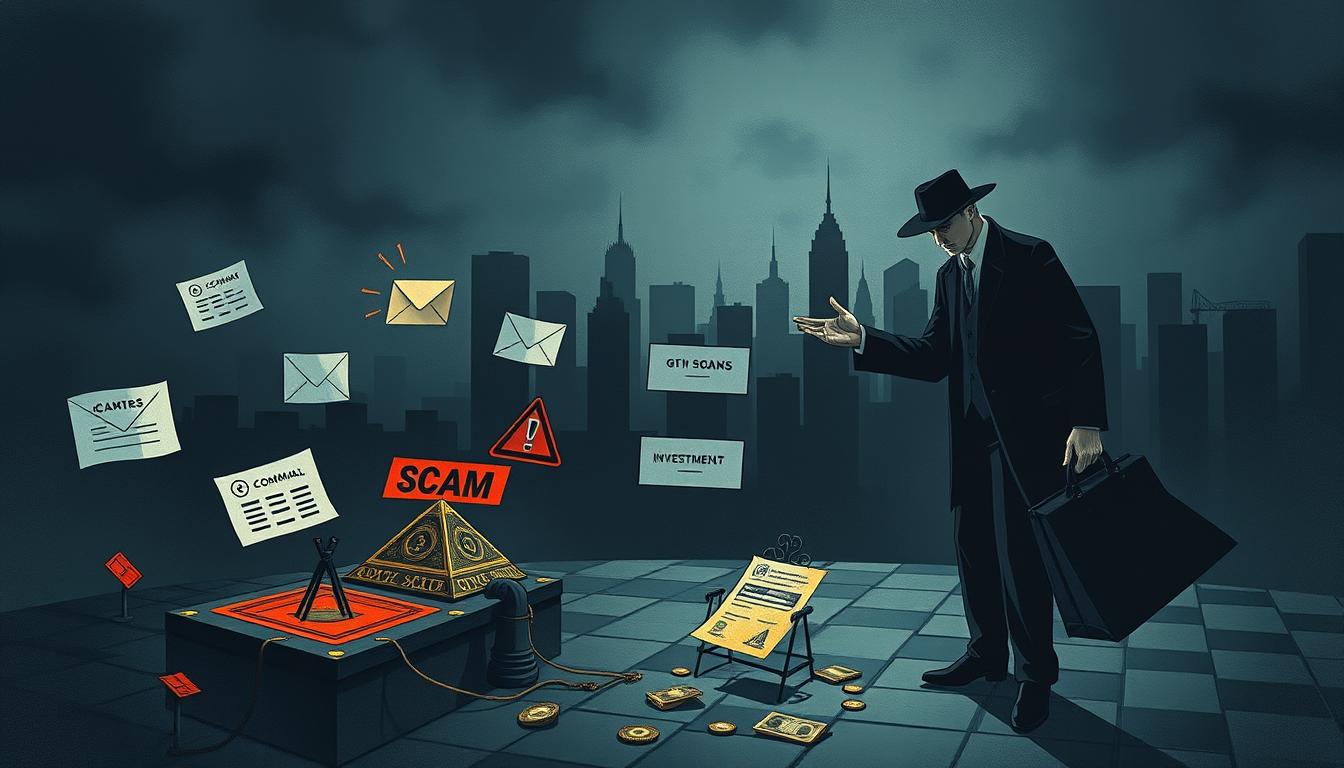Financial scams are on the rise, putting both individuals and businesses at risk. From phishing emails to fake calls pretending to be government agencies, criminals use clever tricks to steal money and personal data.
No one is immune—these schemes target everyday people just as much as large corporations. The FDIC reports that millions fall victim yearly, losing billions combined. Staying alert and informed is your best defense.
Simple steps like verifying suspicious messages, using strong passwords, and monitoring accounts can make a big difference. Awareness and quick action help prevent losses before they happen.
Key Takeaways
- Scams affect individuals and businesses alike.
- Phishing and fake calls are common tactics.
- FDIC data shows billions lost annually.
- Proactive measures reduce risks significantly.
- Always verify unexpected requests for information.
Understanding Financial Scams and Fraud
Deceptive schemes designed to steal your money or personal details are evolving daily. Criminals exploit trust, urgency, and fear to trick victims into handing over sensitive data or funds. Recognizing these tactics is the first step toward staying safe.

What Are Financial Scams?
Financial scams are fraudulent activities aimed at accessing your money or identity. Common types include:
- Phishing: Fake emails or texts pretending to be banks or government agencies.
- Fake checks: Scammers send fraudulent checks, then demand a portion back.
- Impostor scams: Posing as the IRS, FDIC, or tech support to demand payments.
Stolen Social Security numbers or bank details can lead to identity theft, draining accounts or opening credit lines in your name.
Why Scammers Target You
Fraudsters focus on individuals for three key reasons:
| Target | Why? | Example |
|---|---|---|
| Savings | Direct access to cash | Fake investment offers |
| Credit lines | Open loans or cards | Stolen financial information |
| Personal data | Sell on dark web | Phishing for SSNs |
Romance scams on dating apps show how emotional manipulation works. The FTC reports victims losing thousands to fake partners. Seniors and small businesses are especially vulnerable due to perceived savings or limited fraud awareness.
Stay alert for red flags like fake authority claims, urgent demands, or requests for unusual payments. Knowledge is your best defense.
Practical Steps to Protect Yourself from Financial Scams and Fraud
Taking action now can prevent headaches later. Small changes in daily habits create strong defenses against digital threats. Here’s how to build resilience.
Lock Down Sensitive Data
Your bank account and personal details are gold mines for criminals. Keep them under wraps:
- Encrypt files containing Social Security numbers or tax records.
- Avoid public Wi-Fi for transactions—use a VPN if necessary.
- Shred physical documents with financial information before disposal.
“Encryption turns your data into a puzzle only you can solve.”
Fortify Login Credentials
Weak passwords invite trouble. A CISA study found 80% of breaches stem from reused or simple passwords. Fix this:
| Risk | Solution | Tool |
|---|---|---|
| Password reuse | Unique phrases per account | Bitwarden, 1Password |
| No 2FA | Enable multi-factor authentication | Google Authenticator |
| Easy guesses | 12+ characters with symbols | CISA’s password guide |
Scrutinize Digital Communications
Phishing thrives on urgency. Check email senders and hover over links before clicking. Red flags include:
- Misspelled domains (e.g., “paypa1.com”)
- Requests for immediate payment via gift cards
- Attachments from unknown sources
Update Defenses Regularly
Outdated software has holes hackers exploit. Automate these updates:
- Operating systems (Windows, macOS)
- Antivirus programs like Norton or Malwarebytes
- Router firmware
Watch Activity Closely
Set alerts for accounts to catch fraud early. Review monthly statements for odd charges. Report unauthorized transactions within 48 hours to limit liability.
Recognizing Common Scam Tactics
Scammers constantly refine their tricks, making it harder to spot fake requests. They prey on trust, urgency, and gaps in awareness. Learn these schemes to avoid becoming a victim.

Impostor Scams: Government, Banks, or Businesses
Fraudsters pose as the IRS, bank staff, or even Amazon support. They threaten arrests, frozen accounts, or fake fines to scare you into payment.
- IRS impersonators demand wire transfers or gift cards, claiming “back taxes.”
- Fake bank alerts warn of “suspicious activity” to steal login details.
- Scammers impersonating business vendors send fraudulent invoices.
“Legitimate agencies never demand immediate payments via gift cards or crypto.” — FTC
Phishing Emails and Text Messages
Phishing messages mimic trusted brands. Look for generic greetings (“Dear Customer”), typos, or mismatched sender addresses.
Example: A text message claims your credit card is locked, urging you to click a malicious link.
Romance and Online Dating Scams
Fake profiles on dating apps build emotional bonds, then invent emergencies (e.g., medical bills) to request funds. The FTC reports victim losses of $304 million in 2023.
Money Mule and Fake Check Scams
Job offers recruiting “payment processors” are often fronts for money laundering. Scammers send fake checks, ask you to deposit them, and demand a partial “refund.”
Example: A contractor receives an overpaid check and is pressured to return the difference before the bank detects fraud.
Conclusion
Smart habits create strong shields against deceptive schemes. Stay vigilant with emails, update software, and question urgent requests. These steps build layers of security around your account and data.
Report suspicious activity to the FTC or FDIC. Your alertness helps protect others. Explore free resources like the FDIC’s phishing guides or CISA’s ransomware tips for deeper insights.
Fraud evolves, but so can your defenses. Stay informed, stay skeptical, and always verify. With the right steps, you’ll outsmart scams before they strike.
FAQ
What should I do if I receive a suspicious email or text message?
Never click on links or download attachments from unknown senders. Verify the sender’s identity by contacting the company directly using official contact details. Report phishing attempts to the Federal Trade Commission (FTC) or your email provider.
How can I secure my bank account from fraud?
Enable multi-factor authentication, set up transaction alerts, and regularly review statements for unauthorized activity. Avoid sharing account details over calls or messages, even if the caller claims to be from your bank.
What are common signs of a phishing scam?
Watch for urgent language, spelling errors, fake sender addresses, and requests for personal or financial details. Legitimate companies like Chase or PayPal won’t ask for sensitive data via email or text.
How do scammers use phone calls to steal information?
They impersonate government agencies (IRS, Social Security), banks, or tech support to pressure you into revealing personal details. Hang up and call the official number listed on the organization’s website to verify.
Can software updates really prevent scams?
Yes! Updates patch security flaws that hackers exploit. Enable automatic updates for your operating system, antivirus (like Norton or McAfee), and apps to stay protected.
What’s a money mule scam?
Scammers recruit victims to transfer stolen funds, often via fake job offers or romance scams. Never accept money from strangers or forward payments—it’s illegal and could leave you liable.
How do I check if a website is safe?
Look for “https://” and a padlock icon in the address bar. Avoid sites with poor design, pop-ups, or deals that seem too good to be true. Use tools like Google Safe Browsing for verification.


